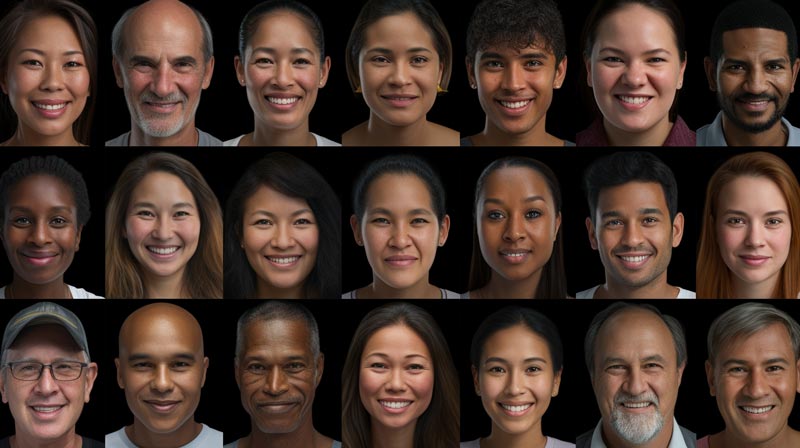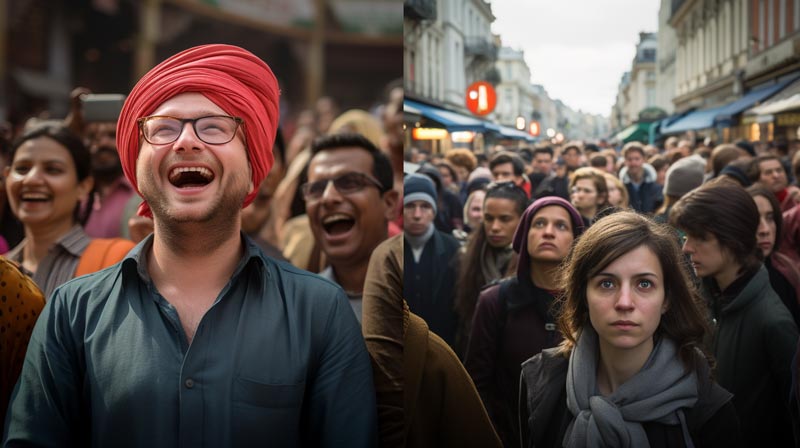Facial Expressions Around the World
‘Facial Expressions Around the World’ marks the next instalment in our riveting five-part series on ’emotions our faces tell’. Imagine each face as an emotional symphony, where every raised eyebrow or pursed lip is a note in a complex arrangement, discernible to anyone, anywhere.
In “A Day in the Life of a Face,” I journeyed through an emotional rollercoaster, examining how one face can be a theatre of war between conflicting emotions like elation and despair within 24 hours. I scrutinised the micro-expressions that often go unnoticed but are instrumental in our day-to-day interactions.
Then, in “The Science of Smiles, Scowls, and Surprises,” I back the flesh to reveal the intricate network of muscles and neurons that animate our facial expressions. We examined how the brain interprets these signals, transforming a simple smile into a powerful social tool or a frown into a shield of disapproval.
In the third instalment, I turn to our current topic: Facial Expressions Around the World. Ever wondered why a smile means the same in London as it does in Tokyo? Or why a frown in Rio de Janeiro could be understood in Nairobi? This post explores how universal facial expressions find unique triggers in different cultures.
I’ll tackle ‘Facial Expression and Cultural Nuances’, ‘The Role of Context in Expressions’, and ‘Universal vs Local: A Fine Balance’. These sections will captivate your curiosity and help us weave them into the narrative to provide evidence-based insights into how different cultures have unique triggers for universal facial expressions.
Eager to read on? Let’s go.

Universal Expressions
Have you ever wondered if a smile means the same in Ghana (my parent’s birthplace) as in the United Kingdom (my birthplace)? Thanks to Paul Ekman’s groundbreaking research on facial expressions around the world, we know it does! Ekman discovered seven universal facial expressions that are hardwired into our brains. These expressions are happiness, sadness, fear, disgust, anger, surprise, and contempt.
Interestingly, Ekman didn’t just stick to urban communities for his study. He ventured into far-off tribes, places untouched by Hollywood or Netflix. And guess what? The expressions remained consistent. So, whether you’re in a bustling city or a remote village, a grin is a grin, and a frown is a frown.
But it’s not just about recognising an emotion. Universal facial expressions serve as the world’s emotional lingua franca. They facilitate communication across different cultures, making it easier for us to understand each other.
So, the next time you travel, remember that your facial expressions are your best guide. They’re universally understood, thanks to Ekman’s work on facial expressions around the world.

Cultural Differences in Expressing Emotions
Don’t let universal facial expressions blind you; culture adds unique seasoning to the emotional mix. A guy called Matsumoto looked at these cultural nuances.
When we consider facial expressions around the world, looking at Japanese culture shows a fascinating approach. According to Matsumoto’s study, the Japanese learn to modulate their emotional displays early. A practice deeply rooted in societal norms. The study shows that this isn’t merely politeness; it’s a form of emotional intelligence engrained in the culture.
In contrast, countries like the United States and Europe encourage more open emotional displays. Matsumoto’s research suggests this isn’t just personal preference but a cultural directive, heavily influenced by individualistic values prioritising the self over the group.
The study introduces ‘display rules,’ a cultural guidebook for how emotions should be shown in various settings. These rules can differ substantially depending on the culture and context. Showing how emotions are appropriately displayed in professional versus personal situations.
Matsumoto’s research also reveals that these cultural nuances are deeply tied to broader societal structures. For example, social hierarchies and legal frameworks can influence how emotions are expressed and interpreted. Your facial expressions, therefore, aren’t just personal; they reflect the cultural landscape you inhabit.
Facial expressions around the world share a universal foundation, but it’s the cultural nuances that add layers of complexity. These expressions provide a window into individual emotions and a lens through which to view broader cultural norms and values.
High-Context vs. Low-Context Cultures
Edward Hall’s “Beyond Culture” introduces us to the intriguing concept of high-context and low-context cultures. In high-context cultures, much of the communication is implicit. People rely on context, shared understandings, and non-verbal cues, such as facial expressions around the world, to convey meaning.
Think of Japan or China, where facial expressions become a nuanced art form, replete with subtle cues and shared understandings.
In contrast, low-context cultures like the United States or Germany place a premium on explicit communication. Here, clarity is king. Words are selected carefully, and facial expressions around the world serve as complementary rather than primary sources of meaning. In these cultures, what you say is generally what you mean, and facial expressions provide additional, but not essential, context.
Hall’s work shows us that this high-context and low-context dichotomy isn’t just about communication; it also spreads through other aspects of culture. For instance, legal systems in high-context cultures may rely more on societal norms and unspoken rules. Whereas in low-context cultures, written contracts and explicit laws hold more weight.
Understanding the relationship between high-context and low-context cultures adds another layer to our exploration of facial expressions around the world. It challenges us to consider how our cultural frameworks influence how we read and interpret the faces of others.
When you next board a British Airways flight on a trip to another country or deal with people from other cultures. Remember, how you interpret facial expressions might say as much about you as it does about them.
Individualism vs Collectivism: Facial Expressions Around the World
Geert Hofstede’s seminal work “Culture’s Consequences” provides a lens to examine how cultures differ on the scale of individualism and collectivism. Let’s consider how these cultural dimensions impact facial expressions around the world.
In individualistic cultures like the U.S. or the U.K., the focus is on the ‘I,’ the unique snowflake that is you. Your facial expressions around the world are viewed as a direct reflection of your personal feelings, almost like a billboard advertising what’s going on inside your head. Here, the subtleties of facial expressions often take a backseat to the spoken word. You’re expected to say what you mean and mean what you say.
Conversely, collectivist cultures, such as those in Asia or Africa, see the ‘We’ as paramount. Facial expressions in these settings aren’t just about you; they’re a communal affair. In fact, facial expressions around the world serve as a harmonious chorus in these cultures, echoing the group’s collective emotional state. The emphasis is on maintaining social harmony, so your face becomes a tool for diplomacy rather than a canvas for personal emotions.
Linking back to high-context and low-context cultures, individualistic societies generally fall into the low-context bracket. The culture expects you to be explicit in your words and facial expressions. Collectivist cultures are generally high-context, where the unsaid, especially the unexpressed, holds significant weight.
Hofstede’s insights add another layer to our understanding of facial expressions around the world. Whether you find yourself in a culture that values the individual or the group, be mindful of the different roles facial expressions can play. They’re not just a personal affair but deeply rooted in cultural values.
Emotion and Social Norms
Have you ever considered how Canadians, Americans, and the Japanese might react to the same heartwarming scene in a film? Safdar’s study spills the beans. While a Canadian might openly weep, an American might hold back the tears. Why? It’s all down to how different societies create rulebooks for showing emotions.
Keeping a poker face in Japan isn’t just for the card table. It’s a whole cultural norm! Holding back emotions publicly isn’t about being cold but respect and social harmony. This approach to emotional display adds another dimension to our understanding of facial expressions around the world.
We’re not only talking about personal quirks; these societal norms are linked to broader frameworks. For example, showing emotions is encouraged in individualistic cultures like the United States. Yet, in collectivist cultures like Japan, it’s the opposite. Emotional restraint is the name of the game.
When you next play the people-watching game, as I do when I sit by the window facing the road in coffee shops. Remember that facial expressions around the world are subject to a complex set of cultural guidelines. Not everyone laughs or cries in the same way or for the same reasons. It’s a cultural kaleidoscope (an optical instrument toy invented by Sir David Brewster around 1816) out there, and you’re part of it!
The Many Faces of ‘Facial Expressions Around the World’
In this enlightening journey through the world of facial expressions, we’ve explored the fascinating chemistry between universal human emotions and the unique cultural triggers that shape them.
From the micro-expressions that fly across our faces in a day to the deep-seated cultural norms governing these expressions, we’ve seen how complex and beautifully varied our emotional language can be.
We’ve researched the scientific foundations laid by researchers like Ekman and Matsumoto. Steered through societal constructs like high-context and low-context cultures. One thing stands clear: Our faces are both a universal and a profoundly personal canvas. Whether in London or Tokyo, Rio or Nairobi, our facial expressions are hardwired yet finely tuned by the cultural landscapes we inhabit.
This post has been a captivating chapter in my series, examining how our faces are an emotional lingua franca. Yet subject to the rich splendour of cultural norms and values. As you sip your coffee and observe the world, remember that each face you see tells a universally understood and intricately unique story.
Eager for the next instalment? Stay tuned.
A Journey Through Expressions:
This article is part 3 of my 5-part series delving into the world of facial expressions.
Past:
- A Day in the Life of a Face – I explored the myriad of emotions our faces display daily, from dawn’s first light to night’s quietude.
- The Science of Smiles, Scowls, and Surprises – I’ve plunged deep into the fascinating science behind why our faces move the way they do, from the neural pathways lighting up our smiles to the muscles crafting our scowls.
Current:
- Facial Expressions Around the World – I delve into the enigmatic interplay between universal emotions and cultural contexts, uncovering how a smile or a frown can mean the same yet be triggered differently across the globe.
Up Next:
- Baby’s First Expressions – A humorous look at how babies masterfully cycle through all seven expressions in mere minutes.
Coming Soon:
- Facial Expressions Challenge – Take on a fun and insightful challenge, consciously adopting each of the seven facial expressions daily.
Stay tuned as we continue this exciting exploration into facial expressions!
Sources
Ekman P, Friesen WV. Constants across cultures in the face and emotion. J Pers Soc Psychol. 1971 Feb;17(2):124-9.
Hall, E. T. (1976). Beyond Culture. Anchor Press
Hofstede, G. (1980). Culture’s Consequences: International Differences in Work-Related Values. Sage Publications.
Matsumoto, D. (1990). Cultural similarities and differences in display rules. Motivation and Emotion, 14(3), 195-214.
Safdar, S., Friedlmeier, W., Matsumoto, D., Yoo, S. H., Kwantes, C. T., Kakai, H., & Shigemasu, E. (2009). Variations of emotional display rules within and across cultures: A comparison between Canada, USA, and Japan. Canadian Journal of Behavioural Science, 41(1), 1-10.
Rinn, W. E. (1984). The Neuropsychology of Facial Expression: A Review of the Neurological and Psychological Mechanisms for Producing Facial Expressions. Psychological Bulletin, 95(1), 52-77. [Accessed 14 August 2023]





